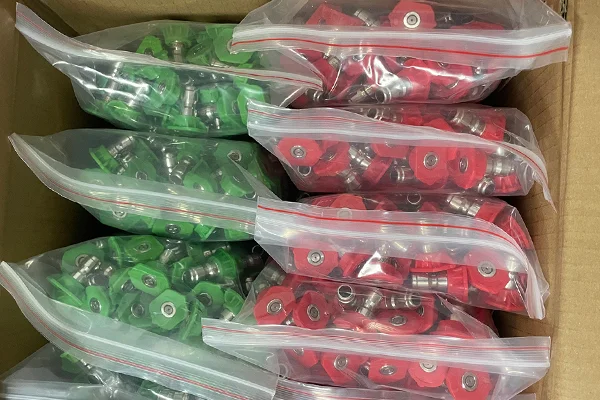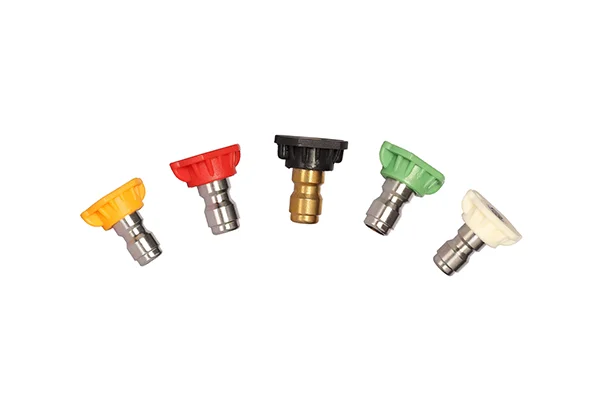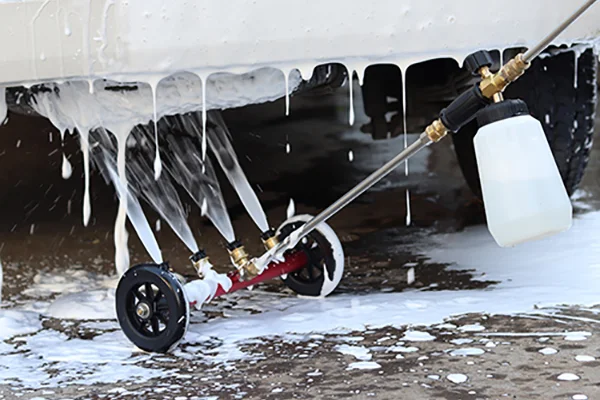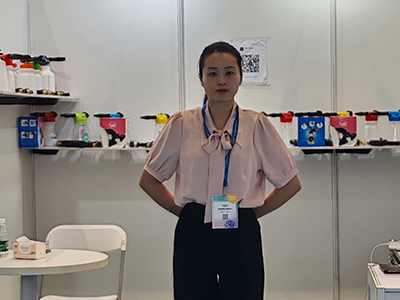Which nozzle is best for car wash?
You’re staring at a set of colorful plastic tips that came with your pressure washer. You know they are important, but you are afraid that picking the wrong one could strip the paint right off your car.
For washing your car, the best nozzle is the black soap nozzle1 for applying foam and the white 40-degree nozzle2 for rinsing. These provide the safest and most effective combination for cleaning without damaging your vehicle's paint.

As a manufacturer of cleaning tools for over 15 years, I see this question come up all the time. Those little colored nozzles aren’t just for looks; they are part of a universal, international standard. Each color represents a specific spray angle3 and, in some cases, a different orifice size. Using the right one is the key to a great car wash. Using the wrong one can not only give you poor results but can also make you think your equipment is broken. Let’s break down what each color means so you can wash your car with confidence.
What do the different colored pressure washer nozzles4 mean?
You have a handful of nozzles: red, yellow, green, white, and black. They all seem similar, but you know there must be a reason for the different colors, and you want to understand it.
The colors on pressure washer nozzles are a standard code for the spray angle of the water. Red is 0°, yellow is 15°, green is 25°, and white is 40°. The black nozzle is different; it's a low-pressure soap nozzle.

The primary purpose of this color-coding system is safety and function. The degree number represents the width of the fan of water that comes out of the tip. A smaller number means a narrower, more concentrated, and more powerful stream. A larger number means a wider, gentler spray. The black nozzle is the exception. While the others are designed for high-pressure water, the black nozzle has a much wider internal opening, or orifice. This design is specifically for "downstreaming" soap or chemicals. It lowers the pressure significantly to allow the pressure washer’s injector to pull soap into the water stream. This standardized system ensures that no matter where you buy your equipment, the colors will always mean the same thing.
Standard Pressure Washer Nozzle Color Code
| Color | Angle | Primary Use |
|---|---|---|
| Red | 0° | Extreme spot cleaning (concrete, metal). Never use on a car. |
| Yellow | 15° | Stripping paint or dirt from hard surfaces. |
| Green | 25° | General cleaning on siding, decks, and driveways. |
| White | 40° | Gentle rinsing of delicate surfaces, like vehicles and windows. |
| Black | Low-Pressure | Applying soap and detergents. |
Why must you use the black nozzle for foam?
You attached your foam cannon, but instead of thick foam, you see a watery mess leaking from the bottle's connection. You think your brand-new foam cannon must be broken or defective.
You must use the black soap nozzle1 for foam because its large orifice is designed to handle the thick consistency of the foam mixture. Using a high-pressure nozzle will create back-pressure, forcing foam to leak out from other areas.

This is the most critical insight I can share. Foam is much thicker and less dense than water. Think about it: foam is just soap and water expanded with air. These tiny air bubbles take up a lot of space. Because of this, the foam mixture needs a very wide opening to exit the cannon smoothly. That is exactly what the black nozzle provides. Its internal opening is significantly larger than any of the high-pressure rinsing nozzles.
What happens if you use a green (25°) or white (40°) nozzle instead? The opening on those nozzles is tiny. The pressure washer tries to force a large volume of thick foam through this small hole. The foam simply can't get out fast enough. This creates a traffic jam, and the pressure builds up backward. The foam has to go somewhere, so it finds the path of least resistance—often the threads where the bottle connects or other seals in the cannon. This is why people mistakenly believe their cannon is leaking. It's not a leak; it's an overflow caused by using the wrong nozzle. Always use the black nozzle for aplicar foam.
Which rinse nozzle should you choose for your car?
The foam has done its job, and now it's time to rinse your car. You want to be fast and efficient, but you also want to be absolutely sure you won't harm the finish.
The white 40-degree nozzle2 is the best and safest choice for rinsing your car. Its wide spray pattern covers a large surface area, allowing you to rinse quickly without concentrating too much pressure on one spot.

After you've let the foam dwell and lift the dirt, rinsing it all away safely is the final step. While the green 25-degree nozzle is a popular choice for all-purpose cleaning, I always recommend the white 40-degree nozzle2 for painted surfaces. The reason is simple: a wider spray fan is a gentler spray fan. The pressure from your machine is distributed over a much larger area, which dramatically reduces the risk of damaging your car's clear coat or chipping paint, especially around emblems or trim pieces. A wider spray also means you can rinse large panels like the roof or hood more quickly and evenly, preventing you from missing spots and leaving behind soap residue. Some professionals might use a 25-degree nozzle from a safe distance, but for most car owners, the white 40-degree nozzle provides the perfect balance of efficiency and safety. It gets the job done right without any of the risks.
Conclusion
Always use the black nozzle for applying foam and the white 40-degree nozzle for rinsing. Understanding this simple color code ensures a safe, effective car wash and prevents misdiagnosing your equipment as faulty.
Explore the significance of the black soap nozzle for effective foam application in pressure washing. ↩
Learn why the white 40-degree nozzle is the safest choice for rinsing your vehicle without damage. ↩
Find out how spray angles affect cleaning efficiency and safety when using a pressure washer. ↩
Discover the various types of pressure washer nozzles and how to choose the right one for your cleaning needs. ↩
